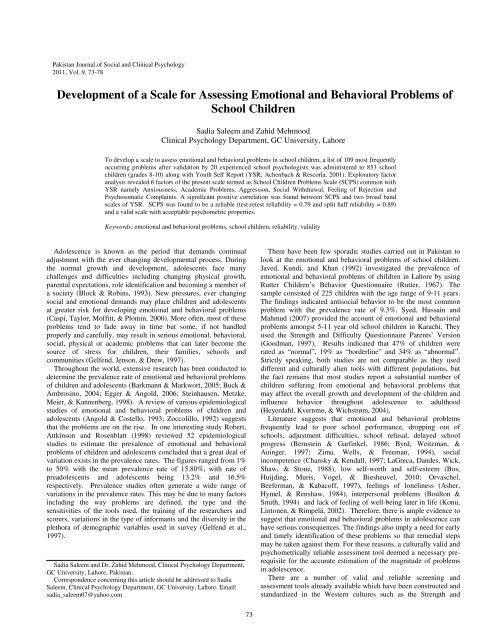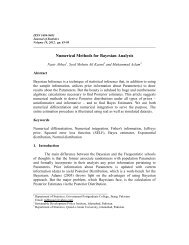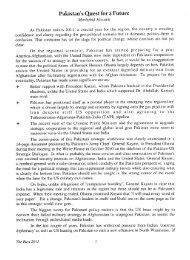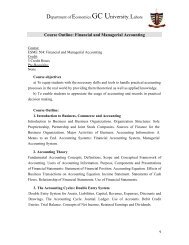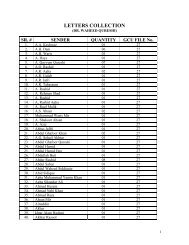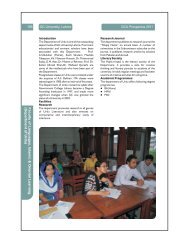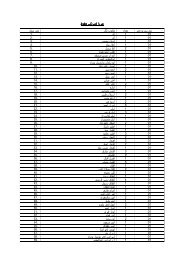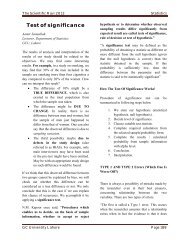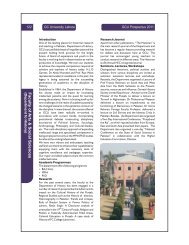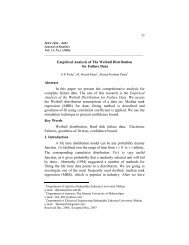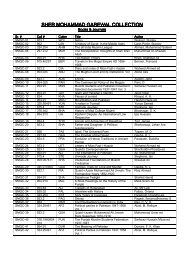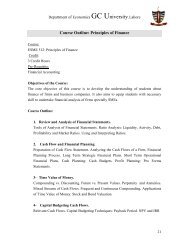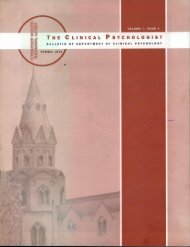Development of a Scale for Assessing Emotional and Behavioral ...
Development of a Scale for Assessing Emotional and Behavioral ...
Development of a Scale for Assessing Emotional and Behavioral ...
Create successful ePaper yourself
Turn your PDF publications into a flip-book with our unique Google optimized e-Paper software.
Pakistan Journal <strong>of</strong> Social <strong>and</strong> Clinical Psychology<br />
2011, Vol. 9, 73-78<br />
<strong>Development</strong> <strong>of</strong> a <strong>Scale</strong> <strong>for</strong> <strong>Assessing</strong> <strong>Emotional</strong> <strong>and</strong> <strong>Behavioral</strong> Problems <strong>of</strong><br />
School Children<br />
Sadia Saleem <strong>and</strong> Zahid Mehmood<br />
Clinical Psychology Department, GC University, Lahore<br />
To develop a scale to assess emotional <strong>and</strong> behavioral problems in school children, a list <strong>of</strong> 109 most frequently<br />
occurring problems after validation by 20 experienced school psychologists was administered to 853 school<br />
children (grades 8-10) along with Youth Self Report (YSR; Achenbach & Rescorla, 2001). Exploratory factor<br />
analysis revealed 6 factors <strong>of</strong> the present scale termed as School Children Problems <strong>Scale</strong> (SCPS) common with<br />
YSR namely Anxiousness, Academic Problems, Aggression, Social Withdrawal, Feeling <strong>of</strong> Rejection <strong>and</strong><br />
Psychosomatic Complaints. A significant positive correlation was found between SCPS <strong>and</strong> two broad b<strong>and</strong><br />
scales <strong>of</strong> YSR. SCPS was found to be a reliable (test-retest reliability = 0.79 <strong>and</strong> split half reliability = 0.89)<br />
<strong>and</strong> a valid scale with acceptable psychometric properties.<br />
Keywords: emotional <strong>and</strong> behavioral problems, school children, reliability, validity<br />
Adolescence is known as the period that dem<strong>and</strong>s continual<br />
adjustment with the ever changing developmental process. During<br />
the normal growth <strong>and</strong> development, adolescents face many<br />
challenges <strong>and</strong> difficulties including changing physical growth,<br />
parental expectations, role identification <strong>and</strong> becoming a member <strong>of</strong><br />
a society (Block & Robins, 1993). New pressures, ever changing<br />
social <strong>and</strong> emotional dem<strong>and</strong>s may place children <strong>and</strong> adolescents<br />
at greater risk <strong>for</strong> developing emotional <strong>and</strong> behavioral problems<br />
(Caspi, Taylor, M<strong>of</strong>fitt, & Plomin, 2000). More <strong>of</strong>ten, most <strong>of</strong> these<br />
problems tend to fade away in time but some, if not h<strong>and</strong>led<br />
properly <strong>and</strong> carefully, may result in serious emotional, behavioral,<br />
social, physical or academic problems that can later become the<br />
source <strong>of</strong> stress <strong>for</strong> children, their families, schools <strong>and</strong><br />
communities (Gelfend, Jenson, & Drew, 1997).<br />
Throughout the world, extensive research has been conducted to<br />
determine the prevalence rate <strong>of</strong> emotional <strong>and</strong> behavioral problems<br />
<strong>of</strong> children <strong>and</strong> adolescents (Barkmann & Markwort, 2005; Buck &<br />
Ambrosino, 2004; Egger & Angold, 2006; Steinhausen, Metzke,<br />
Meier, & Kannenberg, 1998). A review <strong>of</strong> various epidemiological<br />
studies <strong>of</strong> emotional <strong>and</strong> behavioral problems <strong>of</strong> children <strong>and</strong><br />
adolescents (Angold & Costello, 1993; Zoccolillo, 1992) suggests<br />
that the problems are on the rise. In one interesting study Robert,<br />
Attkinson <strong>and</strong> Rosenblatt (1998) reviewed 52 epidemiological<br />
studies to estimate the prevalence <strong>of</strong> emotional <strong>and</strong> behavioral<br />
problems <strong>of</strong> children <strong>and</strong> adolescents concluded that a great deal <strong>of</strong><br />
variation exists in the prevalence rates. The figures ranged from 1%<br />
to 50% with the mean prevalence rate <strong>of</strong> 15.80%, with rate <strong>of</strong><br />
preadolescents <strong>and</strong> adolescents being 13.2% <strong>and</strong> 16.5%<br />
respectively. Prevalence studies <strong>of</strong>ten generate a wide range <strong>of</strong><br />
variations in the prevalence rates. This may be due to many factors<br />
including the way problems are defined, the type <strong>and</strong> the<br />
sensitivities <strong>of</strong> the tools used, the training <strong>of</strong> the researchers <strong>and</strong><br />
scorers, variations in the type <strong>of</strong> in<strong>for</strong>mants <strong>and</strong> the diversity in the<br />
plethora <strong>of</strong> demographic variables used in survey (Gelfend et al.,<br />
1997).<br />
Sadia Saleem <strong>and</strong> Dr. Zahid Mehmood, Clinical Psychology Department,<br />
GC University, Lahore, Pakistan.<br />
Correspondence concerning this article should be addressed to Sadia<br />
Saleem, Clinical Psychology Department, GC University, Lahore. Email:<br />
sadia_saleem07@yahoo.com<br />
There have been few sporadic studies carried out in Pakistan to<br />
look at the emotional <strong>and</strong> behavioral problems <strong>of</strong> school children.<br />
Javed, Kundi, <strong>and</strong> Khan (1992) investigated the prevalence <strong>of</strong><br />
emotional <strong>and</strong> behavioral problems <strong>of</strong> children in Lahore by using<br />
Rutter Children’s Behavior Questionnaire (Rutter, 1967). The<br />
sample consisted <strong>of</strong> 225 children with the age range <strong>of</strong> 9-11 years.<br />
The findings indicated antisocial behavior to be the most common<br />
problem with the prevalence rate <strong>of</strong> 9.3%. Syed, Hussain <strong>and</strong><br />
Mahmud (2007) provided the account <strong>of</strong> emotional <strong>and</strong> behavioral<br />
problems amongst 5-11 year old school children in Karachi. They<br />
used the Strength <strong>and</strong> Difficulty Questionnaire Parents’ Version<br />
(Goodman, 1997). Results indicated that 47% <strong>of</strong> children were<br />
rated as “normal”, 19% as “borderline” <strong>and</strong> 34% as “abnormal”.<br />
Strictly speaking, both studies are not comparable as they used<br />
different <strong>and</strong> culturally alien tools with different populations, but<br />
the fact remains that most studies report a substantial number <strong>of</strong><br />
children suffering from emotional <strong>and</strong> behavioral problems that<br />
may affect the overall growth <strong>and</strong> development <strong>of</strong> the children <strong>and</strong><br />
influence behavior throughout adolescence to adulthood<br />
(Heyerdahl, Kvernmo, & Wichstrøm, 2004).<br />
Literature suggests that emotional <strong>and</strong> behavioral problems<br />
frequently lead to poor school per<strong>for</strong>mance, dropping out <strong>of</strong><br />
schools, adjustment difficulties, school refusal, delayed school<br />
progress (Bernstein & Garfinkel, 1986; Byrd, Weitzman, &<br />
Auinger, 1997; Zima, Wells, & Freeman, 1994), social<br />
incompetence (Chansky & Kendall, 1997; LaGreca, D<strong>and</strong>es, Wick,<br />
Shaw, & Stone, 1988), low self-worth <strong>and</strong> self-esteem (Bos,<br />
Huijding, Muris, Vogel, & Biesheuvel, 2010; Orvaschel,<br />
Beeferman, & Kabac<strong>of</strong>f, 1997), feelings <strong>of</strong> loneliness (Asher,<br />
Hymel, & Renshaw, 1984), interpersonal problems (Boulton &<br />
Smith, 1994) <strong>and</strong> lack <strong>of</strong> feeling <strong>of</strong> well-being later in life (Konu,<br />
Lintonen, & Rimpelä, 2002). There<strong>for</strong>e, there is ample evidence to<br />
suggest that emotional <strong>and</strong> behavioral problems in adolescence can<br />
have serious consequences. The findings also imply a need <strong>for</strong> early<br />
<strong>and</strong> timely identification <strong>of</strong> these problems so that remedial steps<br />
may be taken against them. For these reasons, a culturally valid <strong>and</strong><br />
psychometrically reliable assessment tool deemed a necessary prerequisite<br />
<strong>for</strong> the accurate estimation <strong>of</strong> the magnitude <strong>of</strong> problems<br />
in adolescence.<br />
There are a number <strong>of</strong> valid <strong>and</strong> reliable screening <strong>and</strong><br />
assessment tools already available which have been constructed <strong>and</strong><br />
st<strong>and</strong>ardized in the Western cultures such as the Strength <strong>and</strong><br />
73
SALEEM & MEHMOOD 74<br />
Difficulty Questionnaire (SDQ; Goodman, 1997). SDQ is a brief<br />
mental health questionnaire that consists <strong>of</strong> 25 items grouped into 5<br />
sub-scales covering conduct problems, hyperactivity, emotional,<br />
peer problems <strong>and</strong> prosocial behavior. Separate versions <strong>for</strong><br />
teachers <strong>and</strong> parents are available covering an age range <strong>of</strong> 4-16<br />
years (Goodman, 1997). Another most frequently <strong>and</strong> widely used<br />
assessment tool is the Child Behavior Checklist (CBCL, Achenbach<br />
& Rescorla, 2001) in parent (Parent Report Form; PRF), teacher<br />
(Teacher Report Form; TRF) <strong>and</strong> <strong>for</strong> youth (Youth Self Report;<br />
YSR). CBCL has been used in many studies in different countries to<br />
assess emotional <strong>and</strong> behavioral problems <strong>of</strong> children (e.g. Kazdin,<br />
1989; Larsson & Frisk, 1999; Slobodskaya, 1999). CBCL consists<br />
<strong>of</strong> 112 items measuring two broad b<strong>and</strong> scales called Internalizing<br />
<strong>and</strong> Externalizing problems.<br />
A great deal <strong>of</strong> research is now focusing on the impact <strong>of</strong> culture<br />
on different psychological constructs <strong>and</strong> psychopathology (Chen,<br />
Rubin, & Li, 1995; Draguns &Tanaka-Matsumi, 2003). Researchers<br />
also argue that cultural value system <strong>and</strong> practices give an<br />
indigenous meaning to a social behavior (Wang & Ollendick,<br />
2001). The development, experience, expression <strong>and</strong> manifestation<br />
<strong>of</strong> mental health problems are influenced by cultural experiences<br />
(e.g., Thakker & Ward, 1998; Weisz, Weiss, Suwanlert, &<br />
Chaiyasit, 2003).<br />
Although it can be said that while some pathological behaviors<br />
(e.g. psychoses <strong>and</strong> other organic disorders) may manifest in a more<br />
or less universal way across cultures, <strong>and</strong> virtually are recognized<br />
by all as abnormal, some other <strong>for</strong>ms <strong>of</strong> behaviors (e.g., neurotic<br />
disorders, emotional <strong>and</strong> behavioral problems) are more likely to be<br />
a product <strong>of</strong> individuals’ own experiences, family <strong>and</strong> social<br />
interaction <strong>and</strong> cultural environment (Eisenberg, Pidada, & Liew,<br />
2001; Saleem & Mahmood, 2009). Moreover, the extent to which<br />
such behaviors are perceived as normal or abnormal is usually a<br />
matter <strong>of</strong> social judgment <strong>and</strong> <strong>of</strong> the culture in which they are<br />
observed, rather than the behavior itself (Gelfend et al., 1997).<br />
Such cultural variations <strong>and</strong> diversities in experience, expression<br />
<strong>and</strong> manifestation <strong>of</strong> mental health problems also question the use<br />
<strong>of</strong> assessment <strong>and</strong> screening tools which are developed in different<br />
cultures with different languages <strong>and</strong> are based on different<br />
phenomenological experiences (Gergen, Gulerce, Lock, & Misra,<br />
1996). These instruments <strong>and</strong> tools are more likely to give<br />
inaccurate <strong>and</strong> invalid results ultimately raising questions about the<br />
validity <strong>of</strong> the research (Kim, 2002). It is also very important to<br />
consider that some constructs are relevant to one culture but not <strong>for</strong><br />
others. By using these tools which are developed exclusively in<br />
Western culture with different linguistic expression, we may lose<br />
some <strong>of</strong> the important <strong>and</strong> crucial in<strong>for</strong>mation specifically related to<br />
non-Western cultures (Stewart et al., 1999). The blind application <strong>of</strong><br />
culturally alien tools not only leads to misinterpretation <strong>of</strong> the<br />
problems under study but may also mislead prevention <strong>and</strong><br />
treatment ef<strong>for</strong>ts (Kim, 2002). There<strong>for</strong>e, a plethora <strong>of</strong> literature is<br />
now focusing on cultural meaning <strong>of</strong> the psychological concepts<br />
<strong>and</strong> constructs (e.g., Draguns & Tanaka-Matsumi, 2003; Wang &<br />
Ollendick, 2001).<br />
The above discussion provides a rationale <strong>for</strong> developing an<br />
indigenous scale <strong>for</strong> measuring the emotional <strong>and</strong> behavioral<br />
problems based on the cultural <strong>and</strong> social background <strong>of</strong> Pakistani<br />
school children. Pakistan is a collectivistic society where family <strong>and</strong><br />
group values play a vital role in developing <strong>and</strong> shaping behaviors<br />
<strong>of</strong> the individuals <strong>and</strong> where familial harmony, obedience <strong>and</strong><br />
con<strong>for</strong>mity to parents <strong>and</strong> other authority figures are valued<br />
(Stewart et al., 1999). There<strong>for</strong>e, the psychological <strong>and</strong> mental<br />
health is greatly influenced by the people around them (Markus &<br />
Kitayama, 1991). However, very few systematic ef<strong>for</strong>ts have been<br />
attempted to assess <strong>and</strong> measure mental health problems <strong>of</strong> school<br />
children <strong>and</strong> adolescents in the Pakistani cultural context.<br />
There<strong>for</strong>e, the objectives <strong>of</strong> this study are to identify the experience,<br />
expression <strong>and</strong> manifestation <strong>of</strong> emotional <strong>and</strong> behavioral problems<br />
<strong>of</strong> children within cultural context <strong>of</strong> Pakistan <strong>and</strong> to develop a<br />
valid <strong>and</strong> reliable scale <strong>for</strong> this purpose.<br />
Method<br />
The scale was developed in three stages. Stage 1 describes the<br />
gathering <strong>and</strong> collating procedure <strong>of</strong> emotional <strong>and</strong> behavioral<br />
problems, followed by stage II <strong>of</strong> empirical validation <strong>and</strong> in the<br />
stage III the psychometric properties <strong>of</strong> the scale were established.<br />
Stage 1: Gathering Problems<br />
Initially, the presenting problems <strong>of</strong> 103 referred school children<br />
were gathered <strong>and</strong> collated through their initial interview with the<br />
school psychologists over a period <strong>of</strong> 6 months. These 103 children<br />
had been referred by school authorities <strong>for</strong> various mental health<br />
problems. A list <strong>of</strong> 129 problems was prepared. All those items that<br />
were dubious, vague or overlapping were merged or modified<br />
keeping close to their original connotations. Items that were<br />
expressed in idiosyncratic or slang words were also excluded. In<br />
this way, a final list <strong>of</strong> 119 problems was collated <strong>and</strong> given the<br />
name <strong>of</strong> School Children’s Problems <strong>Scale</strong> (SCPS).<br />
Stage 2: Empirical Validation Through Experts<br />
In order to gather empirical validation <strong>of</strong> the final list <strong>of</strong><br />
emotional <strong>and</strong> behavioral problems, 20 experienced school<br />
psychologists were in<strong>for</strong>med about the purpose <strong>of</strong> the research. All<br />
participants had a minimum 3 years <strong>of</strong> experience with school<br />
children. They were asked to rate each <strong>of</strong> the 119 problems on a 6-<br />
point rating scale ranging from 0 = “not at all” to 5 = “extremely<br />
common” <strong>for</strong> their frequency <strong>of</strong> occurrence in school children.<br />
At the end <strong>of</strong> stage II, all the problems were listed in descending<br />
order <strong>of</strong> frequency <strong>of</strong> occurrence as rated by the experts. Problems<br />
getting less than 20% average score were excluded from the final<br />
list. In this way, a final list <strong>of</strong> 111 problems was retained <strong>and</strong> used<br />
<strong>for</strong> further psychometric properties in stage III.<br />
Pilot Study<br />
Hundred <strong>and</strong> eleven problems were piloted on 60 school children<br />
(30 boys <strong>and</strong> 30 girls) <strong>for</strong> readability <strong>and</strong> to test the layout. Two<br />
problems were excluded from the scale because their wording was<br />
not clear to some children. In this way, 109 problems were retained<br />
<strong>for</strong> further psychometric phase.<br />
Stage 3: Psychometric Properties<br />
Stage III was aimed at establishing the factorial structure, validity<br />
<strong>and</strong> reliability <strong>of</strong> the final set <strong>of</strong> statements termed as School<br />
Children Problem <strong>Scale</strong> (SCPS). A multistage sampling technique<br />
was used to select the sample. In the first stage, stratified sampling<br />
technique was used to divide the sample into two main strata comprising<br />
<strong>of</strong> boys <strong>and</strong> girls <strong>of</strong> government schools <strong>of</strong> Lahore. In the
SCHOOL CHILDREN’S PROBLEM SCALE 75<br />
Table 1<br />
Sample description <strong>of</strong> the participants<br />
Variables<br />
Boys Girls Total<br />
(n = 438) (n = 415) (n = 853)<br />
Gender 51.36 48.64 100<br />
Class<br />
8 th 16.19 15.21 31.40<br />
9 th 17.12 16.60 33.72<br />
10 th 18.05 16.83 34.88<br />
second stage, two main strata were further divided into three substrata<br />
according to grades, i.e., 8 th , 9 th <strong>and</strong> 10 th . Within each strata,<br />
the participants were selected r<strong>and</strong>omly. The final sample consisted<br />
<strong>of</strong> 853 school children (boys = 438, girls = 415) <strong>of</strong> grades 8 th , 9 th<br />
<strong>and</strong> 10 th . The mean age <strong>of</strong> the sample was 13.91 (SD = 1.27). The<br />
sample was collected from 10 mainstream government schools <strong>of</strong><br />
Lahore (Table 1).<br />
Instruments<br />
1. School Children’s Problems <strong>Scale</strong> (SCPS). School Children’s<br />
Problems <strong>Scale</strong> (SCPS) developed in the earlier stages consists <strong>of</strong><br />
109 problems experienced <strong>and</strong> expressed by school children <strong>and</strong> is a<br />
4-point rating scale with options included “Never, Rarely,<br />
Sometimes, <strong>and</strong> Often”.<br />
2. Youth Self Report (YSR; Achenbach & Rescorla, 2001). The<br />
Youth Version <strong>of</strong> Child Behavior Checklist i.e., Youth Self Report<br />
(YSR, Achenbach & Rescorla, 2001) was used. It consists <strong>of</strong> 112<br />
items <strong>for</strong> ages 11-18 years <strong>and</strong> describes a broad range <strong>of</strong> problems.<br />
As mentioned earlier, it is one <strong>of</strong> the most frequently used measures<br />
to assess emotional <strong>and</strong> behavioral problems <strong>of</strong> children. There<strong>for</strong>e,<br />
in order to establish the concurrent validity <strong>of</strong> SCPS, Urdu (national<br />
language <strong>of</strong> Pakistan) version <strong>of</strong> YSR was used.<br />
Procedure<br />
Initially, 16 schools were contacted <strong>and</strong> a brief description <strong>of</strong> the<br />
aims <strong>of</strong> the current research was sent to them. Ten schools agreed to<br />
participate. Each school was personally visited by the researcher<br />
<strong>and</strong> school authorities were in<strong>for</strong>med about the objectives <strong>of</strong> the<br />
research. They were assured that all the in<strong>for</strong>mation would be kept<br />
confidential <strong>and</strong> will only be used <strong>for</strong> research purposes. Once<br />
permission was granted, the school authorities were asked to<br />
provide one section at r<strong>and</strong>om from 8 th , 9 th <strong>and</strong> 10 th class. Children<br />
<strong>of</strong> each class were tested in group settings with an average <strong>of</strong> 30<br />
children in each class.<br />
Firstly, the researcher introduced herself to the participants <strong>and</strong><br />
in<strong>for</strong>med about the purpose <strong>of</strong> the research. All those who agreed to<br />
participate were then provided the final testing protocol comprising<br />
Table 2<br />
Eigen Values <strong>and</strong> Variance Explained by 6 Factors <strong>of</strong> SCPS<br />
Factors Eigen values % <strong>of</strong> variance % <strong>of</strong> total variance<br />
1 16.46 18.49 18.49<br />
2 4.06 4.55 23.05<br />
3 2.74 3.08 26.13<br />
4 1.99 2.24 28.37<br />
5 1.75 1.97 30.34<br />
6 1.66 1.86 32.20<br />
<strong>of</strong> SCPS <strong>and</strong> CBCL. All participants were assured that it’s not an<br />
exam <strong>and</strong> there are no right <strong>and</strong> wrong answers. They were also<br />
assured that their in<strong>for</strong>mation will be kept confidential <strong>and</strong> had<br />
nothing to do with the school authorities. The instructions were<br />
given in Urdu. They were asked to rate each problem to the extent it<br />
bothered them. It took about 25 minutes to complete the protocol.<br />
After completion, each group was given about 20 minutes <strong>for</strong> any<br />
questions, feedback <strong>and</strong> debriefing.<br />
Results<br />
Factor Analysis <strong>of</strong> School Children’s Problems <strong>Scale</strong> (SCPS)<br />
Principle Component Analysis with Varimax Rotation <strong>and</strong><br />
Scree Plot was used to explore the factor structure <strong>of</strong> SCPS. Factors<br />
were also extracted on the basis <strong>of</strong> Eigen value > 1. On the basis <strong>of</strong><br />
factor analysis, factor loadings were assessed. Items with loading <strong>of</strong><br />
Table 3<br />
Sample Items <strong>of</strong> Six Factors <strong>of</strong> SCPS<br />
Factor 1: Anxiousness (23 items)<br />
1. Easily get worried<br />
2. Fear to take initiative<br />
3. Feeling shy<br />
4. Pointless thoughts<br />
5. Fear <strong>of</strong> unknown<br />
Factor 2: Academic Problems (16 items)<br />
1. Lack <strong>of</strong> interest in studies<br />
2. Problems related to home work <strong>and</strong> school work<br />
3. Inability to concentrate<br />
4. Lack <strong>of</strong> confidence<br />
Factor 3: Aggression (15 items)<br />
1. Losing temper easily<br />
2. Inability to sit still<br />
3. Throwing things away in anger<br />
4. Abusive, <strong>and</strong> argues a lot<br />
Factor 4: Social withdrawal (15 items)<br />
1. Avoiding social interaction<br />
2. Indulging in daydreaming<br />
3. Avoiding friends<br />
4. Feeling shy<br />
Factor 5: Feelings <strong>of</strong> Rejection (10 items)<br />
1. Feelings <strong>of</strong> being rejected by teachers <strong>and</strong> parents,<br />
2. Unnecessary interference by parents<br />
3. Nobody listens me<br />
Factor 6: Psychosomatic Problems (15 items)<br />
1. Physical aches <strong>and</strong> pains<br />
2. Headache<br />
3. Feelings <strong>of</strong> nausea<br />
4. Feeling sick<br />
Table 4<br />
Cronbach Alpha <strong>of</strong> SCPS <strong>and</strong> 6 Factors<br />
Factors No <strong>of</strong> items α<br />
Anxiousness 23 0.87<br />
Academic Problems 16 0.84<br />
Aggression 15 0.84<br />
Social Withdrawal 15 0.83<br />
Rejection 10 0.70<br />
Psychosomatic Problems 9 0.76<br />
Total SCPS Score 88 0.92
SALEEM & MEHMOOD 76<br />
Table 5<br />
Summary <strong>of</strong> Intercorrelation, Means <strong>and</strong> St<strong>and</strong>ard Deviations <strong>for</strong> Six Factors <strong>and</strong> Total Score <strong>of</strong> SCPS<br />
Factors 1 2 3 4 5 6 7<br />
1. Anxiousness --- .63** .41** .72** .57** .59** .89**<br />
2. Academic Problems --- --- .57** .55** .59** .39** .81**<br />
3. Aggression --- --- --- .44** .39* .29* .66**<br />
4. Withdrawal --- --- --- --- .53** .54** .83**<br />
5. Rejection --- --- --- --- --- .39* .72**<br />
6. Psychosomatic Problems --- --- --- --- --- --- .66**<br />
7. Total Score --- --- --- --- --- --- ---<br />
M 24.41 18.20 17.72 16.11 6.08 14.93 78.53<br />
SD 13.04 10.68 9.39 8.74 5.02 8.06 35.42<br />
*p < .01. ** p < .001.<br />
.3 or below were eliminated. Eighty eight items were distributed<br />
across 6 factors.<br />
Table 2 indicates the factorial structure <strong>of</strong> SCPS. Scree plot<br />
revealed six factor solutions <strong>of</strong> SCPS. A descriptive label was<br />
assigned to each factor on the basis <strong>of</strong> commonality <strong>of</strong> items in the<br />
factors. The details <strong>of</strong> these six factors are given in Table 3.<br />
Validity <strong>and</strong> Reliability<br />
Concurrent Validity<br />
Concurrent validity <strong>of</strong> SCPS was confirmed with YSR. A<br />
significant positive correlation was found between School<br />
Children’s Problems <strong>Scale</strong> (SCPS) <strong>and</strong> two broad b<strong>and</strong> scales <strong>of</strong><br />
YSR namely Internalizing Problems (r = 0.76, p < 0.001) <strong>and</strong><br />
Externalizing Problems (r = 0.70, p < 0.001).<br />
Table 4 indicates that SCPS has a high internal consistency. Table 5<br />
indicates a significant positive correlation among six factors <strong>and</strong> the<br />
Total Score <strong>of</strong> SCPS.<br />
Test Retest Reliability<br />
One week test retest reliability on 20% (n = 115) sample was r =<br />
0.79, p < 0.001.<br />
Split Half Reliability<br />
Odd <strong>and</strong> even method was used to determine the split half<br />
reliability <strong>of</strong> SCPS showing r = 0.89, p < 0.001.<br />
Discussion<br />
The present study focused on the culture specific experience <strong>and</strong><br />
expression <strong>of</strong> emotional <strong>and</strong> behavioral problems <strong>of</strong> school<br />
children. Initially, a list <strong>of</strong> 129 problems was collated from 103<br />
referred school children. After linguistic modification, a list <strong>of</strong> 119<br />
items was further validated through 20 experienced school<br />
psychologists. The final list <strong>of</strong> 109 problems (School Children’s<br />
Problem <strong>Scale</strong>, SCPS) was administered to 853 school children.<br />
Principle Component factor analysis revealed a six factor solution<br />
<strong>of</strong> SCPS namely Anxiousness, Academic Problems, Aggression,<br />
Social Withdrawal, Feeling <strong>of</strong> Rejection <strong>and</strong> Psychosomatic<br />
Problems. While the four factors Anxiousness, Aggression, Social<br />
Withdrawal <strong>and</strong> Psychosomatic Problems were found to be<br />
consistent with the literature (e.g., Achenbach & Rescorla, 2001).<br />
The factors, Academic Problems <strong>and</strong> Feelings <strong>of</strong> Rejection were<br />
peculiar <strong>for</strong> this sample.<br />
Factor 1 <strong>of</strong> SCPS consisted <strong>of</strong> 23 problems related to anxiety,<br />
worry <strong>and</strong> indulging in pointless thoughts. School children are<br />
perhaps over concerned about how they are viewed <strong>and</strong> evaluated<br />
by their teachers, parents <strong>and</strong> peer group. More specifically,<br />
children <strong>and</strong> adolescents <strong>of</strong> these grades (8 th , 9 th <strong>and</strong> 10 th ) are more<br />
anxious about their school per<strong>for</strong>mance <strong>and</strong> this may influence the<br />
manifestation <strong>of</strong> problems.<br />
Academic problems stood out very prominently in SCPS. In<br />
educational system in Pakistan, these three years, i.e., 8 th , 9 th <strong>and</strong><br />
10 th grades are very crucial <strong>and</strong> critical in every child’s academic<br />
life. These grades play a vital role in the choice <strong>of</strong> career in the<br />
future. As noted in other studies (Isralowitz & Ong, 1990) that<br />
school adjustment <strong>and</strong> choice <strong>of</strong> career are the top concerns <strong>of</strong><br />
adolescents living in Asian countries. There<strong>for</strong>e, it may be possible<br />
that the pressure the child feels in school may bring out some <strong>of</strong> the<br />
emotional <strong>and</strong> behavioral problems that may lead to declined school<br />
per<strong>for</strong>mance. This particular factor <strong>of</strong> academic problems did not<br />
emerge in other similar studies (e.g. Achenbach, 1991; Goodman,<br />
1997) which may reflect the different nature <strong>of</strong> the samples.<br />
The third factor that emerged in factor analysis was Aggression.<br />
This factor consists <strong>of</strong> that items related to direct or indirect<br />
expression <strong>of</strong> anger <strong>and</strong> aggression. This factor is consistent with<br />
other scales (YSR, Achenbach & Rescorla, 2001), where it was<br />
reflective <strong>of</strong> externalizing problems. This factor shows the typical<br />
pattern <strong>of</strong> school children where they have to excel collectively as<br />
well as individually. There<strong>for</strong>e, they may manifest more aggressive<br />
behaviors <strong>and</strong> activities. Other two factors namely Social<br />
Withdrawal <strong>and</strong> Psychosomatic Problems are also consistent with<br />
the literature. Studies have revealed that Asian adolescents tend to<br />
manifest their emotional <strong>and</strong> behavioral problems in terms <strong>of</strong><br />
somatic complaints (Kim, 2002).<br />
The other interesting <strong>and</strong> significant factor that emerged in the<br />
sample was Feeling <strong>of</strong> Rejection. This factor is perhaps more<br />
conspicuous in collectivistic culture like Pakistan than it may be in<br />
the West. Collectivistic culture is marked by overdependence <strong>of</strong> the
SCHOOL CHILDREN’S PROBLEM SCALE 77<br />
child on the family. Family, parents, siblings <strong>and</strong> teachers plays a<br />
vital role in shaping <strong>and</strong> molding a child’s behavior. The child<br />
rearing practices are more traditional where familial harmony,<br />
obedience <strong>and</strong> con<strong>for</strong>mity to parents <strong>and</strong> other authority figures are<br />
valued (Stewart et al., 1999). In the traditional Asian cultures like<br />
Pakistan, childhood period is somewhat prolonged in which<br />
dependence on parents is encouraged <strong>and</strong> children are expected to<br />
respect (Chao, 1994). The family structure is larger, predominately<br />
living in joint family system <strong>and</strong> more hierarchal than in the West.<br />
Children <strong>of</strong> traditional societies are more likely to regress under<br />
pressure than those <strong>of</strong> the Western culture, where they are<br />
encouraged to develop individuality, autonomy <strong>and</strong> independence.<br />
The psychometric properties <strong>of</strong> SCPS were encouraging. The<br />
internal consistency <strong>of</strong> SCPS was established using Cronbach<br />
Alpha, which was 0.92 <strong>for</strong> the whole scale with 88 items after factor<br />
analysis, while the reliability coefficients also showed that the<br />
SCPS was found to have high internal consistency. As the items <strong>of</strong><br />
SCPS were based on the direct experience <strong>and</strong> expression <strong>of</strong> school<br />
children <strong>and</strong> were further validated by experts, there<strong>for</strong>e the scale<br />
satisfied the criteria <strong>of</strong> face <strong>and</strong> content validity.<br />
As far as the concurrent validity was concerned, YSR<br />
(Achenbach & Rescorla, 2001) was used. A significant positive<br />
correlation was found between total SCPS score <strong>and</strong> two broad<br />
b<strong>and</strong> scales <strong>of</strong> CBCL, with Internalizing problems <strong>and</strong> with<br />
Externalizing problems. One week test retest reliability <strong>of</strong> SCPS<br />
was also high.<br />
The scale (SPCS) was divided into two equal halves by using odd<br />
<strong>and</strong> even method to establish the split half reliability which was also<br />
high. High split-half reliability may provide the short versions <strong>of</strong><br />
SCPS <strong>for</strong> quick screening <strong>for</strong> emotional <strong>and</strong> behavioral problems <strong>of</strong><br />
school children.<br />
The present study has contributed significantly by discovering the<br />
culture specific experience <strong>and</strong> expression <strong>of</strong> emotional <strong>and</strong><br />
behavioral problems in Pakistani culture. The School Children’s<br />
Problems <strong>Scale</strong> (SCPS) with acceptable psychometric properties<br />
does have the potential to be used in research. This scale may also<br />
be used to monitor progress <strong>and</strong> effectiveness in therapy, counseling<br />
<strong>and</strong> guidance <strong>of</strong> school children. The present research is also an<br />
attempt to develop an assessment scale measuring different<br />
dimensions <strong>of</strong> emotional <strong>and</strong> behavioral problems <strong>of</strong> school<br />
children <strong>and</strong> is largely based on the empirically derived data as<br />
proposed by Achenbach (1991). This study also emphasizes the use<br />
<strong>of</strong> functional pr<strong>of</strong>ile <strong>of</strong> the child rather than using rigid diagnostic<br />
categories.<br />
Conclusion<br />
This study has addressed the important issue <strong>of</strong> culture specific<br />
manifestation <strong>and</strong> presentation <strong>of</strong> emotional <strong>and</strong> behavioral<br />
problems <strong>of</strong> school children. Results showed that academic<br />
problems <strong>and</strong> feelings <strong>of</strong> rejection are the essential features <strong>of</strong><br />
school children’s experience <strong>and</strong> expression <strong>of</strong> emotional <strong>and</strong><br />
behavioral problems. These problems are absent in most popular<br />
Western measures <strong>of</strong> emotional <strong>and</strong> behavioral problems. Problems<br />
such as anger <strong>and</strong> aggression, social withdrawal <strong>and</strong> psychosomatic<br />
problems found in Western measures are also found to be an<br />
integral <strong>and</strong> important part <strong>of</strong> mental health issues in our culture.<br />
We propose that these might be the core or universal expression<br />
found in any culture. With both core <strong>and</strong> culture specific expression<br />
<strong>of</strong> emotional <strong>and</strong> behavioral problems in SCPS, the accuracy <strong>of</strong><br />
assessing <strong>and</strong> screening mental health issues in school children can<br />
be enhanced. This study could also prove a basic measuring tool to<br />
determine the prevalence <strong>of</strong> emotional <strong>and</strong> behavioral problems <strong>of</strong><br />
school children so that we could have an accurate account <strong>of</strong> the<br />
magnitude <strong>of</strong> the problems.<br />
References<br />
Achenbach, T. M. (1991). Manual <strong>for</strong> the Child Behavior Checklist<br />
<strong>and</strong> 1991 pr<strong>of</strong>ile. Burlington, VT: University Vermont,<br />
Department <strong>of</strong> Psychiatry<br />
Achenbach, T. M., & Rescorla, L. A. (2001). Manual <strong>for</strong> the<br />
ASEBA School-Age <strong>for</strong>ma & pr<strong>of</strong>ile. Vermont University,<br />
Department <strong>of</strong> Psychiatry.<br />
Angold, A., & Costello, E. J. (1993). Depressive comorbidity in<br />
children <strong>and</strong> adolescents: Empirical, theoretical <strong>and</strong><br />
methodological issues. American Journal <strong>of</strong> Psychiatry,<br />
150(12), 1779-1791.<br />
Asher, S. R., Hymel, S., & Renshaw, P. D. (1984). Loneliness in<br />
children. Child <strong>Development</strong>, 55, 1456-1464.<br />
Barkmann, C., & Markwort, C. (2005). <strong>Emotional</strong> <strong>and</strong> behavioral<br />
problems <strong>of</strong> children <strong>and</strong> adolescents in Germany: An<br />
epidemiological screening. Social Psychiatry, Psychiatric<br />
Epidemiology, 40, 357–366.<br />
Bernstein, G. A., & Garfinkel, B. D. (1986). School phobia: The<br />
overlap <strong>of</strong> affective <strong>and</strong> anxiety disorders. Journal <strong>of</strong> the<br />
American Academy <strong>of</strong> Child Psychiatry, 25, 235-241.<br />
Block, J., & Robins, R. W. (1993). A longitudinal study <strong>of</strong><br />
consistency <strong>and</strong> change in selfesteem from early adolescence to<br />
early adulthood. Child <strong>Development</strong>, 64(3), 909-923.<br />
Bos, A. E. R., Huijding, J., Muris, P., Vogel, L. R. R., &<br />
Biesheuvel, J. (2010). Global, contingent <strong>and</strong> implicit selfesteem<br />
<strong>and</strong> psychopathological symptoms in adolescents.<br />
Personality <strong>and</strong> Individual Differences, 48, 311–316.<br />
Boulton, M. J., & Smith, P. K. (1994). Bully/victim problems in<br />
middle-school children: Stability, self perceived competence,<br />
peer perceptions <strong>and</strong> peer acceptance. British Journal <strong>of</strong><br />
<strong>Development</strong>al Psychology, 12, 315-329.<br />
Buck, K. A., & Ambrosino, R. J. (2004). Children with severe<br />
behavior problems: A survey <strong>of</strong> Texas child care centers'<br />
responses. Early Childhood Education Journal, 31(4), 241-246.<br />
Byrd, R. S., Weitzman, M., & Auinger, P. (1997). Increased<br />
behavior problems associated with delayed school entry <strong>and</strong><br />
delayed school progress. Pediatrics, 100, 654-661.<br />
Caspi, A., Taylor, A., M<strong>of</strong>fitt, T. E., & Plomin, R.<br />
(2000).Neighborhood deprivation affects children’s mental<br />
health: Environmental risks identified in a genetic design.<br />
Psychological Science, 11, 338-342.<br />
Chansky, T. E., & Kendall, P. C. (1997). Social expectancies <strong>and</strong><br />
self-perceptions in anxiety-disordered children. Journal <strong>of</strong><br />
Anxiety Disorders, 11, 347-363.<br />
Chao, R. K. (1994). Beyond parental control <strong>and</strong> authoritarian<br />
parenting style, underst<strong>and</strong>ing Chinese parenting through the<br />
cultural notion <strong>of</strong> training. Child <strong>Development</strong>, 65, 1111-1119.<br />
Chen, X., Rubin, K. H., & Li, Z. Y. (1995). Social functioning <strong>and</strong><br />
adjustment in Chinese children: A longitudinal study.<br />
<strong>Development</strong>al Psychology, 31, 531-539.<br />
Draguns, J. G., & Tanaka-Matsumi, J. (2003). Assessment <strong>of</strong><br />
psychopathology across <strong>and</strong> within cultures: issues <strong>and</strong><br />
findings. Behaviour Research <strong>and</strong> Therapy, 41, 755-776.<br />
Egger, H. L., & Angold, A. (2006). Common emotional <strong>and</strong><br />
behavioral disorders in preschool children: Presentation,
SALEEM & MEHMOOD 78<br />
nosology, <strong>and</strong> epidemiology. Journal <strong>of</strong> Child Psychology <strong>and</strong><br />
Psychiatry <strong>and</strong> Allied Disciplines, 47(3-4), 313-337.<br />
Eisenberg, N., Pidada, S., & Liew, J. (2001). The relations <strong>of</strong><br />
regulation <strong>and</strong> negative emotionality to Indonesian children’s<br />
social functioning. Child <strong>Development</strong>, 72, 1747-1763.<br />
Gelfend, D. M., Jenson, W. R., & Drew, C. J. (1997).<br />
Underst<strong>and</strong>ing Child Behavior Disorder (3 rd ed.). Australia:<br />
Wadsworth.<br />
Gergen, K. J., Gulerce, A., Lock, A., & Misra, G. (1996).<br />
Psychological science in a cultural context. American<br />
Psychologist, 51, 496-503.<br />
Goodman, R. (1997). The strengths <strong>and</strong> difficulties questionnaire: A<br />
research note. Journal <strong>of</strong> Child Psychology <strong>and</strong> Psychiatry, 38,<br />
581 -586.<br />
Heyerdahl, C., Kvernmo, S., & Wichstrøm, L. (2004). Self-reported<br />
behavioural/emotional problems in Norwegian adolescents from<br />
multiethnic areas. European Child <strong>and</strong> Adolescent Psychiatry,<br />
13, 64-72.<br />
Isralowitz, R. E., & Ong, T. H. (1990). Singapore youth: The<br />
impact <strong>of</strong> social status on perception <strong>of</strong> adolescent problems.<br />
Adolescence, 25, 358-362.<br />
Javed, M. A., Kundi, M. Z., & Khan, P. A. (1992). <strong>Emotional</strong> <strong>and</strong><br />
behavioral problems among school children in Pakistan.<br />
Journal <strong>of</strong> the Pakistan Medical Association, 42(8), 181-183.<br />
Kazdin, A. E. (1989). <strong>Development</strong>al psychology. Current research<br />
issues <strong>and</strong> direction. Journal <strong>of</strong> American Psychologist, 44(2),<br />
180-187.<br />
Kim, M. T. (2002). Measuring depression among Korean<br />
Americans: <strong>Development</strong> <strong>of</strong> the Kim depression scale <strong>for</strong><br />
Korean Americans. Journal <strong>of</strong> Transcultural Nursing, 13(2),<br />
109-117.<br />
Konu, T. P., Lintonen, M. K., & Rimpelä, A. (2002). Factors<br />
associated with School children's general subjective well-being.<br />
Health Education Research, 17(2), 155-165.<br />
LaGreca, A. M., D<strong>and</strong>es, S. K., Wick, P., Shaw, K., & Stone, W. L.<br />
(1988). <strong>Development</strong> <strong>of</strong> the social anxiety scale <strong>for</strong> children:<br />
Reliability <strong>and</strong> concurrent validity. Journal <strong>of</strong> Clinical Child<br />
Psychology, 17, 84-91.<br />
Larsson, B., & Frisk, M. (1999). Social competence <strong>and</strong><br />
emotional/behavior problems in 6-16 year old Swedish school<br />
children. European Child <strong>and</strong> Adolescent Psychiatry, 8, 24-33.<br />
Markus, H. R., & Kitayama, S. (1991). Culture <strong>and</strong> the self;<br />
Implications <strong>for</strong> cognition, emotion, <strong>and</strong> motivation.<br />
Psychological Review, 98, 224-253.<br />
Orvaschel, H., Beeferman, D., & Kabac<strong>of</strong>f, R. (1997). Depression,<br />
self-esteem, sex, <strong>and</strong> age in a child <strong>and</strong> adolescent clinical<br />
sample. Journal <strong>of</strong> Clinical Child Psychology, 26, 285-289.<br />
Robert, R. E., Attkinson, C. C., & Rosenblatt, A. (1998). Prevalence<br />
<strong>of</strong> psychopathology among children <strong>and</strong> adolescents. American<br />
Journal <strong>of</strong> Psychiatry, 155, 715-725.<br />
Rutter, M. A. (1967). Children’s behavior questionnaire <strong>for</strong><br />
completion by teachers, preliminary findings. Journal <strong>of</strong> Child<br />
Psychology Psychiatry, 8, 1-11.<br />
Saleem, S., & Mahmood, Z. (2009). OCD in a cultural context: A<br />
phenomenological approach. Pakistan Journal <strong>of</strong> Psychological<br />
Research, 24(1-2), 27-42.<br />
Slobodskaya, H. R. (1999). Competence, emotional <strong>and</strong> behavioural<br />
problems in Russian adolescents. European Child <strong>and</strong><br />
Adolescent Psychiatry, 8, 173-180.<br />
Steinhausen, H. C., Metzke, C. W., Meier, M., & Kannenberg, R.<br />
(1998). Prevalence <strong>of</strong> child <strong>and</strong> adolescent psychiatric<br />
disorders; the Zurich epidemiological study, Acta Psychiatric<br />
Sc<strong>and</strong>navica , 98, 262-271.<br />
Stewart, S. M., Bond, M. H., Zaman, R. M., McBride-Chang, C.,<br />
Rao, N., Ho, M. L., et al. (1999). Functional parenting in<br />
Pakistan. International Journal <strong>of</strong> <strong>Behavioral</strong> <strong>Development</strong>,<br />
23(3), 747-770.<br />
Syed, E. U., Hussain, S. A., & Mahmud, S. (2007). Screening <strong>for</strong><br />
emotional <strong>and</strong> behavioral problems amongst 5-11 years old<br />
school children in Karachi, Pakistan. Social Psychiatry,<br />
Psychiatric Epidemiology, 42, 421-427.<br />
Thakker, J., & Ward, T. (1998). Culture <strong>and</strong> classification: The<br />
cross-cultural application <strong>of</strong> the DSM-IV. Clinical Psychology<br />
Review, 18(5), 501–529.<br />
Wang ,Y., & Ollendick, T. H. (2001). A cross-cultural <strong>and</strong><br />
developmental analysis <strong>of</strong> self-esteem in Chinese <strong>and</strong> Western<br />
children. Clinical Child <strong>and</strong> Family Psychology Review, 4, 253-<br />
271.<br />
Weisz, J. R., Weiss, R., Sawanlert, S., & Chaiyasit, W. (2003).<br />
Syndromal structure <strong>of</strong> psychopathology in children <strong>of</strong><br />
Thail<strong>and</strong> <strong>and</strong> the United States. Journal <strong>of</strong> Consulting <strong>and</strong><br />
Clinical Psychology, 71, 375-385.<br />
Zima, B. T., Wells, K. B., & Freeman, H. E. (1994). <strong>Emotional</strong> <strong>and</strong><br />
behavioral problems <strong>and</strong> severe academic delays among<br />
sheltered homeless children in Los Angeles County. American<br />
Journal <strong>of</strong> Public Health, 84(2), 260-264.<br />
Zoccolillo, M. (1992). Co-occurrence <strong>of</strong> conduct disorder <strong>and</strong> its<br />
adult outcomes with depressive <strong>and</strong> anxiety disorders: A<br />
review. Journal <strong>of</strong> the American Academy <strong>of</strong> Child <strong>and</strong><br />
Adolescent Psychiatry, 31(3), 547-556.<br />
Received April, 2010<br />
Revision Received July, 2011<br />
Accepted August, 2011


